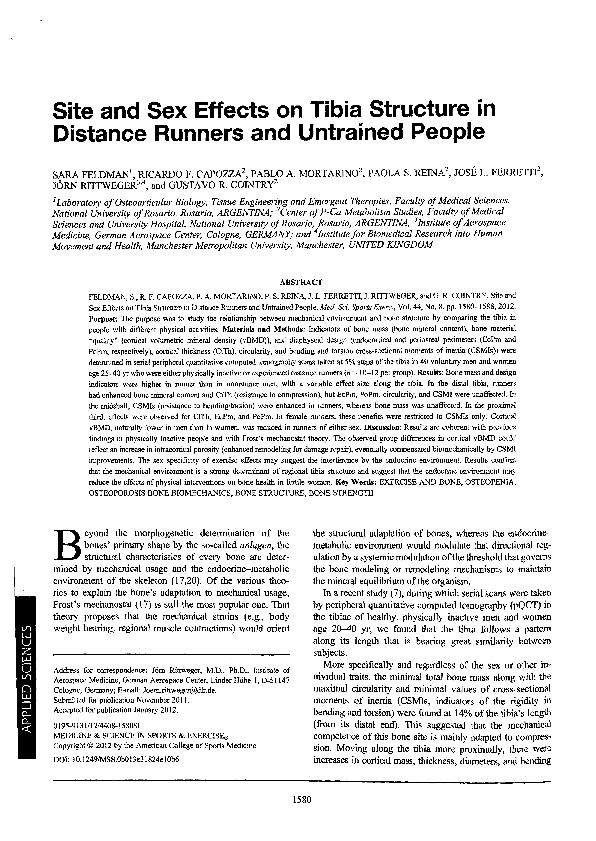Artículo
Site and sex effects on tibia structure in distance runners and untrained people
Feldman, Sara ; Capozza, Ricardo Francisco
; Capozza, Ricardo Francisco ; Mortarino, Pablo A.; Reina, Paola Soledad
; Mortarino, Pablo A.; Reina, Paola Soledad ; Ferretti, Jose Luis
; Ferretti, Jose Luis ; Rittweger, Jörn; Cointry, Gustavo Roberto
; Rittweger, Jörn; Cointry, Gustavo Roberto
 ; Capozza, Ricardo Francisco
; Capozza, Ricardo Francisco ; Mortarino, Pablo A.; Reina, Paola Soledad
; Mortarino, Pablo A.; Reina, Paola Soledad ; Ferretti, Jose Luis
; Ferretti, Jose Luis ; Rittweger, Jörn; Cointry, Gustavo Roberto
; Rittweger, Jörn; Cointry, Gustavo Roberto
Fecha de publicación:
08/2012
Editorial:
Lippincott Williams
Revista:
Medicine And Science In Sports And Exercise
ISSN:
0195-9131
Idioma:
Inglés
Tipo de recurso:
Artículo publicado
Clasificación temática:
Resumen
Purpose: The purpose was to study the relationship between mechanical environment and bone structure by comparing the tibia in people with different physical activities. Materials and Methods: Indicators of bone mass (bone mineral content), bone material "quality" (cortical volumetric mineral density (vBMD)), and diaphyseal design (endocortical and periosteal perimeters (EcPm and PoPm, respectively), cortical thickness (CtTh), circularity, and bending and torsion cross-sectional moments of inertia (CSMIs)) were determined in serial peripheral quantitative computed tomography scans taken at 5% steps of the tibia in 40 voluntary men and women age 25-40 yr who were either physically inactive or experienced distance runners (n = 10-12 per group). Results: Bone mass and design indicators were higher in runner than in nonrunner men, with a variable effect size along the tibia. In the distal tibia, runners had enhanced bone mineral content and CtTh (resistance to compression), but EcPm, PoPm, circularity, and CSMI were unaffected. In the midshaft, CSMIs (resistance to bending/torsion) were enhanced in runners, whereas bone mass was unaffected. In the proximal third, effects were observed for CtTh, EcPm, and PoPm. In female runners, these benefits were restricted to CSMIs only. Cortical vBMD, naturally lower in men than in women, was reduced in runners of either sex. DISCUSSION: Results are coherent with previous findings in physically inactive people and with Frost's mechanostat theory. The observed group differences in cortical vBMD could reflect an increase in intracortical porosity (enhanced remodeling for damage repair), eventually compensated biomechanically by CSMI improvements. The sex specificity of exercise effects may suggest the interference by the endocrine environment. Results confirm that the mechanical environment is a strong determinant of regional tibia structure and suggest that the endocrine environment may reduce the effects of physical interventions on bone health in fertile women.
Archivos asociados
Licencia
Identificadores
Colecciones
Articulos(CCT - ROSARIO)
Articulos de CTRO.CIENTIFICO TECNOL.CONICET - ROSARIO
Articulos de CTRO.CIENTIFICO TECNOL.CONICET - ROSARIO
Citación
Feldman, Sara; Capozza, Ricardo Francisco; Mortarino, Pablo A.; Reina, Paola Soledad; Ferretti, Jose Luis; et al.; Site and sex effects on tibia structure in distance runners and untrained people; Lippincott Williams; Medicine And Science In Sports And Exercise; 44; 8; 8-2012; 1580-1588
Compartir
Altmétricas



